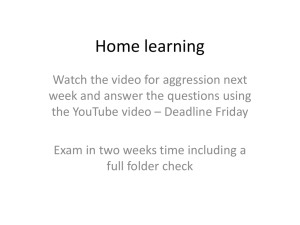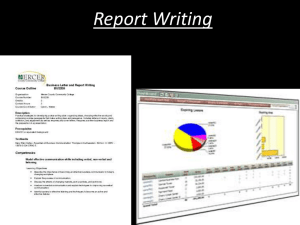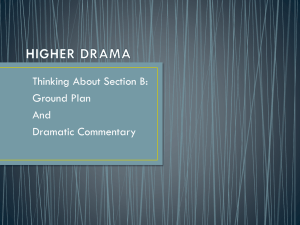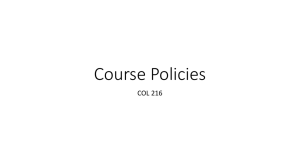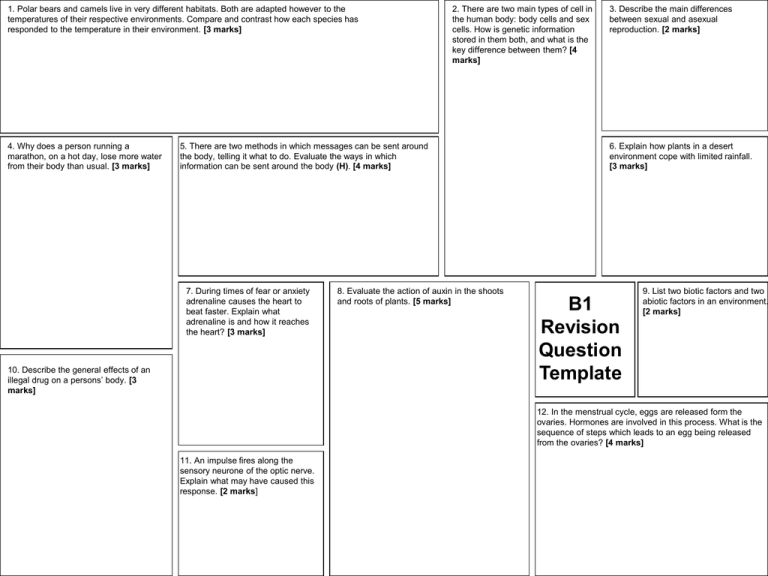
1. Polar bears and camels live in very different habitats. Both are adapted however to the
temperatures of their respective environments. Compare and contrast how each species has
responded to the temperature in their environment. [3 marks]
4. Why does a person running a
marathon, on a hot day, lose more water
from their body than usual. [3 marks]
2. There are two main types of cell in
the human body: body cells and sex
cells. How is genetic information
stored in them both, and what is the
key difference between them? [4
marks]
5. There are two methods in which messages can be sent around
the body, telling it what to do. Evaluate the ways in which
information can be sent around the body (H). [4 marks]
7. During times of fear or anxiety
adrenaline causes the heart to
beat faster. Explain what
adrenaline is and how it reaches
the heart? [3 marks]
10. Describe the general effects of an
illegal drug on a persons’ body. [3
marks]
8. Evaluate the action of auxin in the shoots
and roots of plants. [5 marks]
3. Describe the main differences
between sexual and asexual
reproduction. [2 marks]
6. Explain how plants in a desert
environment cope with limited rainfall.
[3 marks]
B1
Revision
Question
Template
9. List two biotic factors and two
abiotic factors in an environment.
[2 marks]
12. In the menstrual cycle, eggs are released form the
ovaries. Hormones are involved in this process. What is the
sequence of steps which leads to an egg being released
from the ovaries? [4 marks]
11. An impulse fires along the
sensory neurone of the optic nerve.
Explain what may have caused this
response. [2 marks]
13. A young bird falls from its nest and unfortunately dies. No
other animal eats it. Explain the ways in which the carbon
stored in this dead organic matter can be returned to the
atmosphere. [4 marks]
16. What is a pathogen? [1 mark]
17. Antibodies and antitoxins combat different types
of pathogens and in different ways. Compare and
contrast the action of these two types of immune
response. [4 marks]
20. What is evolution? [2 marks]
23. Fossils provide evidence of evolutionary
relationships between modern and extinct species.
Explain why fossil evidence is often difficult to
interpret. [2 marks]
14. In a grassland environment rabbits happily graze
on large quantities of grass. However, a predatory fox
eats rabbits. This fox is infested with fleas. Draw and
label a pyramid of numbers to represent the feeding
relationships in this environment. [2 marks]
15. Draw and pyramid of biomass to represent the example food chain
outlined in question 14. Explain any differences in the shape of this
pyramid. [4 marks]
18. The Golden Tamarin is a critically endangered species of monkey – less than 50 exist in the wild.
Recently, embryonic transplantation has been used to try and increase their numbers, using the Common
Tamarin as a donor and surrogate.
b) The offspring produced are
a) Outline the method used in this process. [5 marks]
genetically identical to each other, but
have characteristics of both the
Golden and Common Tamarin. Why is
this? [2 marks]
21. A species of moth (the peppered moth) lives in woodland downwind from a
nearby industrial estate. Deposits of soot accumulate on the bark of the tress
here. In 2002, shortly after the estate was built, the moth population was made up
of white coloured individuals. When resampled again in 2012 however, the
majority of moths were all of a new dark coloured form. Explain how this change
may have arisen. [5 marks]
19. The leaf of a plant is
exposed to light rays from the
sun amounting to 600kJ of
energy. Only 15kJ of this is
used by the plant in
photosynthesis. What is the
plant’s energy efficiency? [2
marks]
22. Outline a) how bacteria have been genetically
engineered to produce human insulin, and b) how the
insulin is made. NB. The sequence on the poster summary
is not in the correct order! [4 marks]



